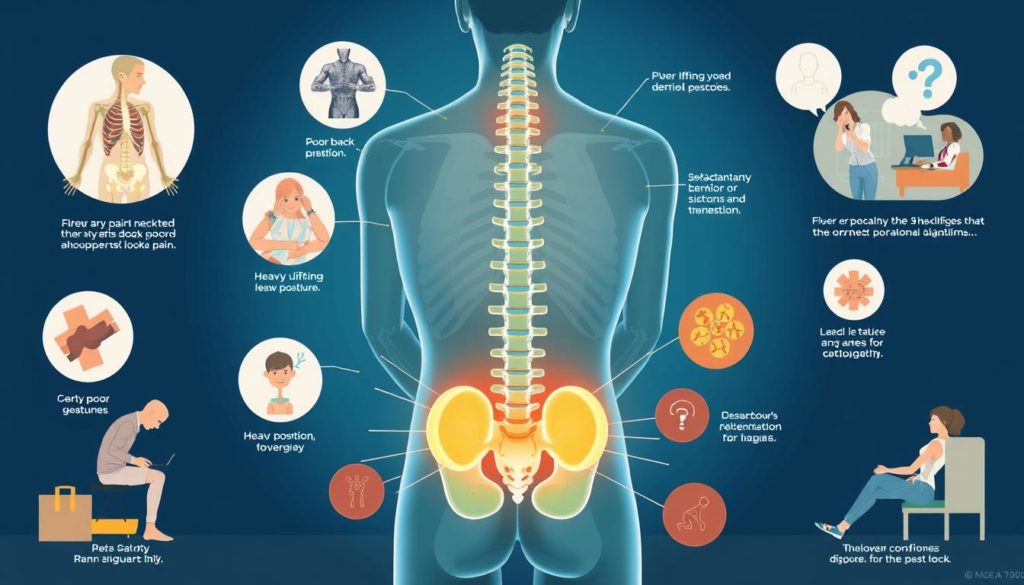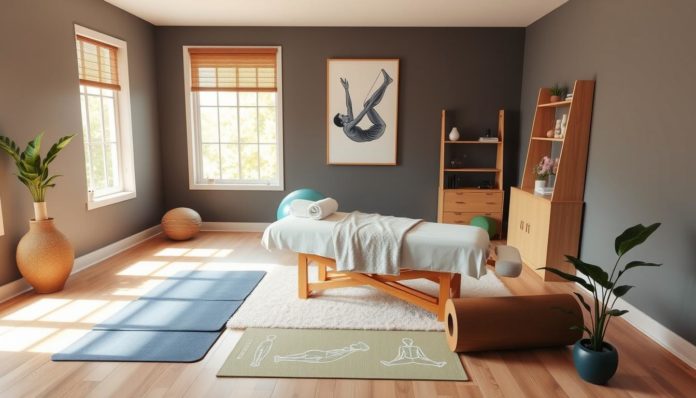Dealing with low back pain can be tough. But there’s good news. Many effective treatment options are available. These treatments range from physical therapy and chiropractic care to non-surgical methods. They help manage pain and improve life quality.
First off, it’s key to figure out what’s causing your low back pain. Doctors may do physical exams and use tests like X-rays or MRI scans. These identify issues like arthritis, herniated discs, or spinal stenosis. Often, simple home remedies like pain relievers and heat therapy can lessen the pain.
For ongoing pain, experts might suggest stronger management options, like prescription drugs or physical therapy. Also, treatments like chiropractic adjustments, acupuncture, and lifestyle changes are gaining popularity. They offer a whole-body approach to easing pain.
Finding the best treatment plan means looking at how bad your pain is, what you prefer, and advice from doctors. This article will cover various treatments. Our goal is to help you find the best way to handle your low back pain.
Understanding Low Back Pain: Causes and Symptoms

Millions suffer from low back pain. To tackle it, we need to grasp its causes and symptoms.
Common Causes of Low Back Pain
Many things cause low back pain. It often comes with getting older, like arthritis in the spine. This arthritis can wear down spinal joints. Another issue is spinal stenosis, which means the spinal canal gets narrow.
Disc issues, such as herniated or bulging discs, can press on nerves, causing pain. There’s also myofascial pain syndrome, featuring muscle pain without a clear cause. Knowing these causes helps in creating effective treatment plans.
Symptoms to Watch Out For
Noticing symptoms of low back pain early is key. Look for decreased movement, muscle spasms, and ongoing pain. Such pain makes daily tasks hard. If pain lasts for months, it affects both body and mind.
Doctors use exams and imaging to find what’s wrong and decide on the best treatment. This step is critical.
Physical Therapy for Low Back Pain
Physical therapy is key in handling low back pain. It does more than ease pain. It also makes muscles stronger to avoid future problems.
Benefits of Physical Therapy
Physical therapy for low back pain brings many benefits. It provides a non-invasive way to manage pain. It also helps return to normal activities. Key advantages include:
- Improved strength and flexibility
- Better posture
- Reduced pain flare-ups
- Education on movement modifications
Types of Physical Therapy Exercises
There are effective low back pain relief exercises. These exercises help relieve discomfort and stop it from coming back. They are good for both therapy sessions and home. They work on:
- Strengthening exercises: These focus on core muscles to support your back.
- Stretching exercises: They improve flexibility and ease muscle tightness.
- Aerobic conditioning: This boosts overall health and endurance.

How to Find a Good Physical Therapist
Choosing the right therapist is vital for top low back pain care. Here’s what to consider when looking for one:
- Credentials: Check they’re licensed and experienced.
- Specialization: Find experts in low back pain.
- Reviews: Read feedback from other patients.
- Personal comfort: Pick someone you’re comfortable with to get the best care.
| Criterion | Details |
|---|---|
| Credentials | Licensed and experienced in physical therapy |
| Specialization | Specializes in low back pain treatment |
| Reviews | Positive testimonials from patients |
| Personal Comfort | Comfortable interaction with the therapist |
Chiropractic Care for Low Back Pain
Chiropractic adjustments are a popular choice for treating low back pain without surgery. They focus on fixing spinal issues and improving mobility. If you’re thinking about trying chiropractic care, it’s good to know what involves and how to pick a skilled practitioner.
What to Expect from Chiropractic Adjustments
Chiropractic care starts with a detailed exam, followed by adjustments to ease pain and enhance function. Through precise movements, the therapy aims to lessen nerve issues and boost movement range. This can greatly benefit those suffering from back problems.
Effectiveness of Chiropractic Care
Studies have shown that chiropractic care can effectively treat low back pain. It offers a non-surgical option for those wanting to avoid surgery. Many patients experience less pain and a better quality of life after regular visits.
Finding the Right Chiropractor
Finding a skilled chiropractor is key for successful treatment. Look for someone with excellent feedback and reviews. A chiropractor’s credentials and experience are very important for getting good results.
Medications for Low Back Pain Relief
Looking for relief from low back pain? Medications are often the first step. They range from simple over-the-counter options to stronger prescription drugs. All aim to ease discomfort and enhance your life.
Over-the-Counter Pain Relievers
Ibuprofen (Advil) and acetaminophen (Tylenol) are two over-the-counter choices. They’re easy to get and can lessen inflammation and pain. You don’t even need a doctor’s prescription.
Prescription Medications
Severe low back pain might need prescription meds. Options include muscle relaxants and narcotics. Antidepressants and topical pain relievers are also used. They specifically target certain aspects of low back pain, offering more relief for chronic or acute sufferers.
Risks and Side Effects
However, these medications can have risks and side effects. It’s vital to use them under a doctor’s care. This avoids issues like dependency and stomach problems. Talk to your doctor to use them safely and effectively.
Exercises and Stretching for Low Back Pain Relief
A good exercise and stretching plan is key to managing low back pain well. Low Back Pain Relief Exercises focus on strengthening the core. This builds strength and stability. Stretching makes you more flexible and less tense.
Low Back Pain Relief Exercises
Strengthening your abdominal, back, and leg muscles can help reduce low back pain. Some good exercises are:
- Pelvic tilts
- Partial crunches
- Wall sits
- Hamstring stretches
Stretching Techniques for Flexibility
Being flexible helps prevent stiffness and lowers the chances of low back pain coming back. Try these stretches to get more flexible:
- Knee-to-chest stretches
- Cat-cow stretches
- Seated forward bend
- Cobra stretch
Maintaining a Regular Exercise Routine
Staying consistent is important for managing low back pain. A regular routine of Low Back Pain Relief Exercises and Stretching for Low Back Pain brings ongoing improvement and long-lasting benefits. Here are some tips to help you keep a regular routine:
- Set realistic goals and slowly up the challenge
- Do a mix of strength, stretching, and aerobic exercises
- Keep things interesting by changing your routine
- Keep track of your progress and celebrate your successes
An approach that combines exercise and stretching helps manage Low Back Pain Management Options. It supports your back’s health overall. This makes daily tasks easier and more fun.
Non-surgical Low Back Pain Treatment Options
Many people look for ways to treat low back pain without surgery. Luckily, there are effective methods available. These options use modern technology and medical knowledge to help control pain and improve how you move.
Injections and Nerve Blocks
Some people get relief from injections and nerve blocks. Cortisone injections are one way to lessen swelling in the painful area. They can really help with the pain. Another method is radiofrequency ablation, which heats nerve tissue to stop pain signals. This can give pain relief for a longer time.
Electrical Nerve Stimulation Therapies
Electrical nerve stimulation therapies use a weak electric current to help with pain. You can use TENS units at home. For ongoing pain relief, some people get nerve stimulators put inside their body. By stopping pain signals, these treatments can be a big help.
Laser and Ultrasound Treatments
Laser and ultrasound treatments are aimed at the sore spots to promote recovery and pain relief. Lasers send focused light deep into tissues to lessen swelling and help cells repair themselves. Ultrasound uses sound waves to improve blood flow and ease pain. Both are modern ways to manage low back pain without needing surgery.
Effective Low Back Pain Treatment Options
Managing low back pain involves different methods. The right diagnosis and a custom treatment plan are essential. These should match the person’s specific needs and pain level. By using a mix of therapies, patients can feel less pain and function better every day.
Physical therapies and exercises are key to treating low back pain. Doing specific exercises regularly can make core muscles stronger. This improves flexibility and lowers the risk of getting hurt again. These activities, along with proper stretching, can make a big difference in reducing pain and improving how well you can move.
Medications are also important for managing pain. Options include over-the-counter painkillers, prescribed drugs, and even acupuncture. Using these methods together can help relieve pain well. They also support overall health.
Making lifestyle changes is part of treating low back pain effectively. It’s important to keep a healthy weight, stand and sit correctly, and stay active. These steps not only help with pain relief but also keep your spine healthy for a long time.
The best low back pain treatment plans use a full approach. They consider what each patient uniquely needs. By combining physical therapies, medications, exercises, and lifestyle changes, people can find the best way to manage their pain. This leads to a better life overall.
Natural Remedies for Low Back Pain
Many people with low back pain turn to natural remedies for relief. These can enhance conventional treatments very well.
Herbal and Nutritional Supplements
Herbs and supplements are recognized for easing low back pain. Turmeric fights inflammation, which can lessen pain. Omega-3 fatty acids, from fish oil, aid joint health, reducing discomfort. Always talk to a healthcare provider before trying new supplements for your back.
Essential Oils and Aromatherapy
Essential oils and aromatherapy are gaining fans for back pain care. Oils like lavender and peppermint can be rubbed on the back. They also work great in a diffuser. Combined with other natural remedies, they offer a complete approach to ease pain.
Below is a table showing different natural remedies and their benefits:
| Natural Remedy | Potential Benefits |
|---|---|
| Turmeric | Reduces inflammation and pain |
| Omega-3 Fatty Acids | Supports joint health |
| Lavender Essential Oil | Promotes relaxation and pain relief |
| Peppermint Oil | Provides a cooling effect and relieves pain |
| Eucalyptus Oil | Reduces inflammation and pain |
Remember, always discuss new treatments with a healthcare provider. This ensures your back pain management is both safe and suited to your needs.
Holistic Approaches to Low Back Pain
Effective treatment of chronic low back pain takes a full approach. It focuses on both the body and mind. Holistic methods like mindfulness, acupuncture, and yoga are great for those looking for more than common treatments.
Mindfulness and Meditation
Mindfulness and meditation are becoming key in managing low back pain. They lessen stress and anxiety. This lets people handle pain better and boosts their life quality.
Adding mindfulness in your daily life changes how you feel pain. It brings relaxation and clear thinking.
Acupuncture and Acupressure
Studies show acupuncture can really help with low back pain. This old Chinese practice uses tiny needles to open energy flow and ease pain. Acupressure does the same but with pressure, not needles.
Both methods strive to lessen pain and swelling. They also aim to make moving around easier. Read more on this holistic approach helpful for lower back.
Yoga and Tai Chi
Yoga helps a lot with low back pain. It makes you more flexible, strong, and aware of your body. It uses poses that stretch back muscles, aiding in relief and preventing more pain.
Tai Chi’s slow movements also help with balance and stress. It’s great for dealing with ongoing pain. Both encourage linking mind and body, crucial for full recovery.
Adding these holistic approaches to low back pain to everyday life can really improve pain control. Whether it’s through mindfulness, acupuncture, or yoga, you find many ways to a better, painless life.
Surgical Treatment for Low Back Pain
Surgery is often seen as the last choice for treating low back pain. It comes into play after trying all other methods without success. Imaging tests need to show issues like herniated discs or spinal stenosis for surgery to be considered. It’s vital to weigh the pros and cons of surgery for back pain. Getting a second opinion is key to making a well-informed choice.
When to Consider Surgery
Patients might think about surgery when non-surgical methods don’t help. If there’s severe pain or problems like weakness, surgery could be the answer. Before choosing surgery, patients must get tests like MRI or CT scans. These tests confirm if structural problems are causing their symptoms.
Types of Back Surgery Available
There are a few surgical options for low back pain. A discectomy removes part of a herniated disc to relieve nerve pressure. In contrast, a laminectomy takes out part of the vertebrae. This is often for spinal stenosis, making more space for nerves. Spinal fusion, another option, joins vertebrae to lessen motion and pain from conditions like spondylolisthesis. Each surgery has its own benefits and risks.
Recovery and Rehabilitation Post-Surgery
Recovery and rehab are crucial after surgery. Success relies on starting physical therapy soon after the operation. The goal is to improve strength, flexibility, and prevent more injuries. Making lifestyle changes, like managing weight and improving ergonomics, matters too. Understanding the recovery process and following your doctor’s advice is vital. It helps patients get back to everyday life with less pain.
FAQ
What are the best low back pain treatment options?
The top choices for low back pain include physical therapy, medications, and chiropractic care. Natural remedies and surgery might also help, depending on your condition and pain.
What causes low back pain?
Low back pain can come from aging, like arthritis or disc problems. It also happens from muscle strains, often due to bad posture or lifting heavy things.
What symptoms should I watch out for with low back pain?
Watch for symptoms like less mobility, muscle spasms, and continuous pain. These can mess with your daily life and mindset. It’s key to get checked to find out what’s causing your pain.
How can physical therapy help with low back pain?
Physical therapy boosts strength in your back and abs. It also helps with flexibility and posture. A therapist will show you how to move to avoid making the pain worse.
Are chiropractic adjustments effective for low back pain?
Chiropractic adjustments can ease pain and help with movement. Not everyone will find them helpful, so pick a chiropractor who comes well-recommended.
What medications are available for low back pain relief?
You can use meds like ibuprofen, muscle relaxants, and even some antidepressants for pain. Always follow your doctor’s advice to keep away from side effects.
What are some good low back pain relief exercises?
Exercises that make your core strong and flexible help your spine. Regular workouts and stretches can lessen pain. Always ask a pro for exercises that fit you.
What are non-surgical treatment options for low back pain?
Options without surgery include cortisone shots and radiofrequency ablation. There are also nerve stimulators and therapies using tech like laser. They offer pain relief without surgery’s risks.
Are there natural remedies for low back pain?
Natural remedies include herbs, supplements, and essential oils. They can ease pain and fight inflammation. Always check with your doctor before trying them.
What are holistic approaches to managing low back pain?
Things like mindfulness, acupuncture, yoga, and tai chi focus on connecting mind and body. They can lessen pain, help with movement, and keep you active.
When should surgery be considered for low back pain?
Surgery is an option when other treatments don’t work, and there are clear issues seen in scans. Common surgeries include discectomy and spinal fusion. Consider the pros and cons carefully.


